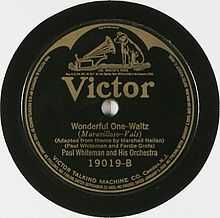Wonderful One

The music was written by Paul Whiteman and Ferde Grofé, the lyrics by Theodora Morse (also known as Dorothy Terris), based on a theme by movie director Marshall Neilan, "Adapted from a Theme by Marshall Neilan". The song was published in 1922 by Leo Feist in New York as a "Waltz Song" which was dedicated "To Julie".
The song is a well-known jazz and pop standard, recorded by many artists, including Gertrude Moody, Edward Miller, Martha Pryor, Helen Moretti, John McCormack who released it as Victor 961, and Pete Bontsema in 1923. Henry Burr recorded the song in 1924 and Glenn Miller and his Orchestra in 1940. The Paul Whiteman Orchestra recorded the song three times, in acoustical and electrical versions, and released it as a single.
Movie Appearances
"Wonderful One" appeared in the following movies: Agatha (1979), The Chump Champ (1950), Little 'Tinker (1948), Red Hot Riding Hood (1943), Sufferin' Cats (1943), Design for Scandal (1941), Strike Up the Band (1940), and Westward Passage (1932).
The song was also featured in the 1950 MGM movie To Please a Lady starring Clark Gable and Barbara Stanwyck.
Recordings of "Wonderful One"
- Paul Whiteman and His Orchestra, 1922, original instrumental version on Victor
- Martha Pryor, 1923
- Edward Miller, 1923
- Gertrude Moody, 1923
- John McCormack, 1923
- Pete Bontsema, 1923
- Henry Burr, 1924
- Glenn Miller and His Orchestra, 1939, on RCA Bluebird
- The Chordettes, 1953
- Paul Weston and His Orchestra, 1953, instrumental version
- Ken Griffin, 1954, instrumental
- Mel Tormé, 1955
- The McGuire Sisters, 1956
- Tony Bennett, 1960, To My Wonderful One album
- David Whitfield, 1961
- Della Reese, 1963
- Jerry Vale, 1963
- Bent Fabric, 1964
- Doris Day, 1967
- Bill Kenny of The Ink Spots
- Vera Lynn
- Woody Herman
- Helen Moretti
- Dave Frishberg
- Fred Hartley
- Floyd Dixon
- Mari Jones

Lyrics
(MY) WONDERFUL ONE
(Paul Whiteman/ Ferde Grofé / Marshall Neilan / Dorothy Terriss)
My wonderful one that I love you so
Awake or sleeping
My hearts's in your keeping
And calling to you soft and low
My wonderful one
Whenever I'm dreaming
Love's lovelight a-gleaming I see
My wonderful one
How my arms ache to hold, dear
To cuddle and fold you to me
Just you, only you
In the shadowy twilight
In silvery moonlight
There's none like you, I adore you
My life I'll live for you,
Oh, my wonderful, wonderful one
External links
- U.S. Library of Congress. National Jukebox. Paul Whiteman recording.
- U.S. Library of Congress. National Jukebox. Henry Burr recording.
- U.S. Library of Congress. National Jukebox. John McCormack recording.
- The Interactive Tony Bennett Discography: Wonderful One.